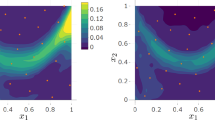Abstract
The reliability-based design optimization (RBDO) using performance measure approach for problems with correlated input variables requires a transformation from the correlated input random variables into independent standard normal variables. For the transformation with correlated input variables, the two most representative transformations, the Rosenblatt and Nataf transformations, are investigated. The Rosenblatt transformation requires a joint cumulative distribution function (CDF). Thus, the Rosenblatt transformation can be used only if the joint CDF is given or input variables are independent. In the Nataf transformation, the joint CDF is approximated using the Gaussian copula, marginal CDFs, and covariance of the input correlated variables. Using the generated CDF, the correlated input variables are transformed into correlated normal variables and then the correlated normal variables are transformed into independent standard normal variables through a linear transformation. Thus, the Nataf transformation can accurately estimates joint normal and some lognormal CDFs of the input variable that cover broad engineering applications. This paper develops a PMA-based RBDO method for problems with correlated random input variables using the Gaussian copula. Several numerical examples show that the correlated random input variables significantly affect RBDO results.
Similar content being viewed by others
References
Arora JS (2004) Introduction to optimum design, 2nd edn. Elsevier, Amsterdam
Basu AP, Sun K (1997) Multivariate exponential distributions with constant failure rates. J Multivar Anal 61:159–169
Block HW, Basu AP (1974) A continuous multivariate exponential extension. Am Stat Assoc 69:1031–1037
Ditlevsen O, Madsen HO (1996) Structural reliability methods. Wiley, New York
Freund JE (1961) A bivariate extension of the exponential distribution. J Am Stat Assoc 56:971–977
Gembel EJ (1965) Two systems of bivariate extremal distributions. 35th Sessions of the International Statistical Institute no. 69, Beograd
Hahn GJ, Shapiro SS (1994) Statistical models in engineering. Wiley, New York
Hohenbichler M, Rackwitz R (1981) Nonnormal dependent vectors in structural reliability. J Eng Mech ASCE 107:1127–1238
Kotz S, Barlakrishnan N, Johnson NL (2000) Continuous multivariate distribution, vol 1, 2nd edn. Wiley, New York
Lee I, Choi KK, Du L, Gorsich D (2008) Dimension reduction method for reliability-based robust design optimization. Comput Struct 86:1550–1562
Liu P-L, Der Kiureghian A (1986) Multivariate distribution models with prescribed marginals and covariances. Probab Eng Mech 1(2):105–112
Madsen HO, Krenk S, Lind NC (1986) Methods of structural safety. Prentice-Hall, Englewood Cliffs, NJ
Marshall AW, Olkin I (1967) A multivariate exponential distribution. J Am Stat Assoc 62:30–44
Melchers RE (1999) Structural reliability analysis and prediction, 2nd edn. Wiley, New York
Nataf A (1962) Détermination des distributions de probabilités dont les marges sont données. C R Hebd SeÂances Acad Sci 255:42–43
Raftery AE (1984) A continuous multivariate exponential distribution. Commun Stat Theory Methods 13:947–965
Rosenblatt M (1952) Remarks on a multivariate transformation. Ann Math Stat 23:470–472
Roser BN (1999) An introduction to copulas. Springer, New York
Socie DF (2003) Seminar notes: Probabilistic aspects of fatigue. http://www.fatiguecaculator.com
Tobias PA, Trindade DC (1995) Applied reliability, 2nd edn. CRC, Boca Raton, FL
Youn BD, Choi KK, Du L (2005a) Adaptive probability analysis using an enhanced hybrid mean value method. Struct Multidiscipl Optim 29(2):134–148
Youn BD, Choi KK, Du L (2005b) Enriched performance measure approach for reliability-based design optimization. AIAA J 43(4):874–884
Youn BD, Xi Z, Wells LJ (2007) Sensitivity-free probability analysis: eigenvector dimension reduction (EDR) method and its extensive applications. 7th world congress on structural and multidisciplinary optimization, Seoul, Korea, May 21–25, pp 2316–2325
Author information
Authors and Affiliations
Corresponding author
Rights and permissions
About this article
Cite this article
Noh, Y., Choi, K.K. & Du, L. Reliability-based design optimization of problems with correlated input variables using a Gaussian Copula. Struct Multidisc Optim 38, 1–16 (2009). https://doi.org/10.1007/s00158-008-0277-9
Received:
Revised:
Accepted:
Published:
Issue Date:
DOI: https://doi.org/10.1007/s00158-008-0277-9




